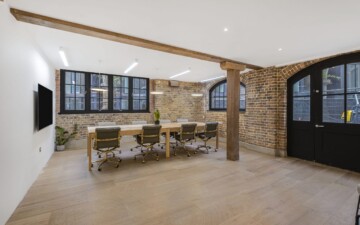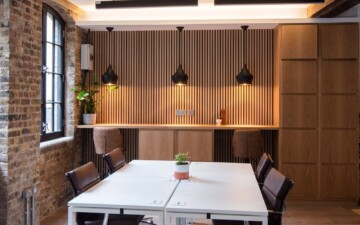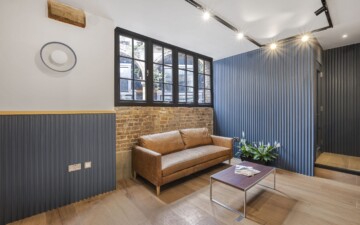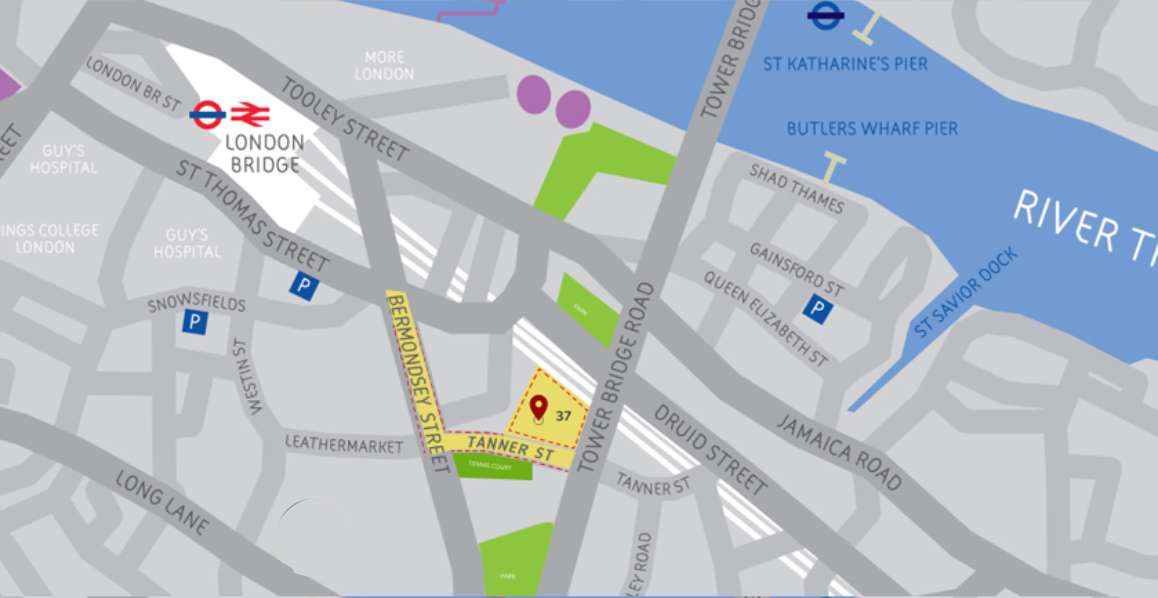COVID-19 has significantly altered the usual 9-to-5 routine in the workplace. It has created opportunities for remote work and flexible hours. However, this transition has raised concerns about the relevance of traditional offices. While remote work is ideal for some individuals, others still prefer traditional workspaces. In today’s evolving work culture, the concept of dynamic workplace management plays a pivotal role in achieving goals for businesses throughout the world. In one of our previous blogs, we learned about how dynamic office spaces drive productivity. In this blog, will explore the components of a dynamic workplace and its significance in today’s professional world.
What Is A Dynamic Workplace?
A dynamic workplace is an environment that promotes adaptability, collaboration, innovation, and ongoing learning. Within a dynamic workplace environment, employees feel empowered to take initiative, explore new ideas, and adapt to change. Communication flows openly, and teams work seamlessly to overcome obstacles and pursue opportunities. This dynamic setting nurtures innovation, enhances efficiency, and enables organisations to thrive in an ever-evolving business landscape.
How Do Dynamic Workplaces Improve Employee Experiences?
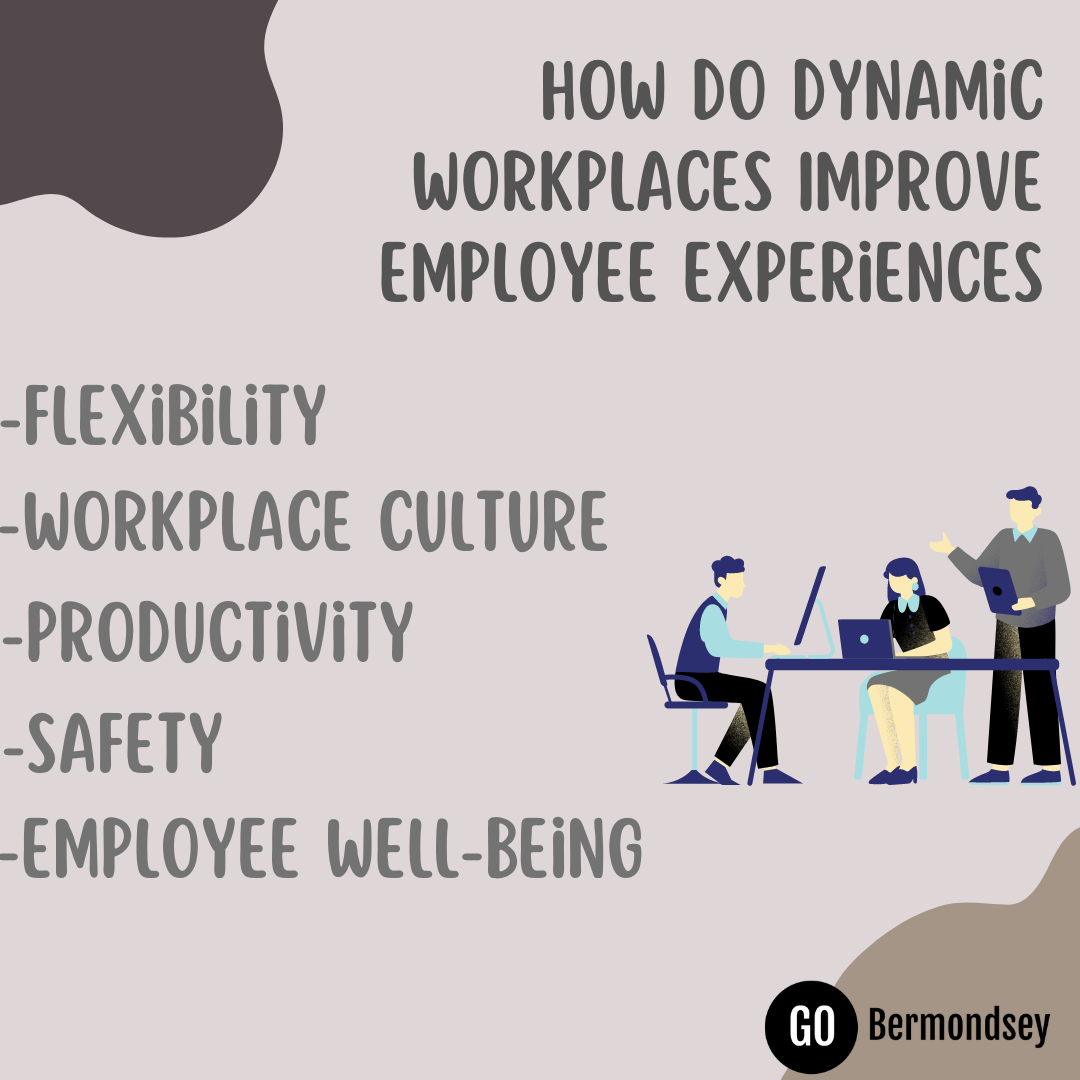
Here are some ways in which dynamic workplaces significantly enhance employee experiences:
| Flexibility |
Dynamic workplaces prioritise flexibility by offering remote work options, flexible schedules, and activity-based workspaces. This enables employees to balance their professional and personal lives, resulting in reduced stress, higher morale, and more job satisfaction. |
| Workplace Culture |
A positive workplace culture fosters collaboration, innovation, and mutual respect among employees. Dynamic work environments embrace diversity, foster collaboration, and promote ongoing learning. They enhance inclusivity and teamwork by fostering open communication, cross-functional collaboration, and employee-focused initiatives. |
| Productivity |
Dynamic workplaces leverage technology and innovative processes to improve workflow efficiency. Offering essential resources and freedom enables employees to work effectively, increasing productivity and job satisfaction. |
| Safety |
Prioritising employee safety builds trust and security in the workplace. This includes setting up ergonomic workstations, adhering to safety protocols, and encouraging open communication. Cutting-edge technology and creative design increase workplace safety, boosting employee confidence and offering peace of mind. |
| Employee Well-Being |
Dynamic workplaces prioritise employee well-being, including physical, mental, and emotional wellness. They offer mental health support, wellness programmes, and activities to promote work-life balance. When employees feel valued and appreciated, they tend to be more engaged and motivated. |
What Is Dynamic Workplace Management?
Dynamic workplace management is all about improving the workplace for everyone involved by adjusting to evolving work environments, and addressing the demands of both employees and employers while remaining aligned with the company’s values. This requires integrated systems, accurate information, and the automation of time-consuming tasks that divert attention away from critical objectives.
In simpler terms, dynamic workplace management involves:
- Enhancing the office environment through informed decisions
- Ensuring employee satisfaction and appreciation at work
- Creating office environments that cater to various needs and preferences
Also read, The Evolution of Eco-consciousness at Modern workplace
Why Is There A Need To Manage A Dynamic Workplace?
Managing a dynamic workplace is critical for several reasons:
- Adaptability: Working in a dynamic work environment demands the ability to adapt according to changes. Active workplace management, whether driven by internal changes such as new initiatives or restructuring, or external events such as economic fluctuations or technological advancements, guarantees flexibility and support for employees during transitions.
- Employee Experience: Dynamic work environments offer employees greater autonomy and flexibility, which can boost morale and enhance productivity. However, this requires open communication and clear expectations. Management is essential for ensuring that employees get the resources and support they need to succeed in a constantly changing environment.
Static Vs. Dynamic Workplace Management: What is the Difference?
The table below elucidates the key differences between static and dynamic work management:
| Feature |
Static Workplace Management |
Dynamic Workplace Management |
| Work Style |
Employees are assigned designated workstations, usually in the form of cubicles or private offices. |
Depending on their tasks, employees can choose their work desks, which can include dedicated desks, collaboration zones, or quiet areas. |
| Employee Needs |
This approach overlooks individual work style preferences. |
Different workspace options are available to accommodate varying requirements, including quiet areas for focus and collaborative zones for teamwork. |
| Space Management |
The workspace layout is permanent and difficult to alter. |
The workspace can be reconfigured to accommodate evolving requirements. Employees can use any available workstation instead of having a dedicated one. |
| Data Usage |
There is a lack of sufficient information to make decisions regarding the workspace. |
Data is used to discover efficient methods to utilise the available space.
|
| Decision-Making |
Changes to the work environment are rare and require a substantial amount of work. |
Space usage is constantly monitored and frequent adjustments are made to optimise for current needs. |
| Scalability |
The workspace lacks flexibility to accommodate changes in employee numbers or work methods. |
A flexible workspace can easily adjust to accommodate a growing or shrinking workforce. |
What is the process of managing dynamic workplaces?
Dynamic workplace management involves creating and maintaining a flexible, efficient, and adaptive work environment that can respond to the evolving needs of a business and its employees. Here’s a detailed look at the process:
-
Assessment and Planning:
- Needs Assessment: Evaluate the current workspace and identify the needs and preferences of the employees. This includes understanding the types of tasks performed, the need for collaboration vs. focused work, and employee preferences for remote or in-office work.
- Space Planning: Develop a flexible space plan that can be easily reconfigured. This involves designing areas that can serve multiple purposes, such as modular furniture that can be rearranged, and spaces that can transition between open collaboration areas and private workstations.
-
Technology Integration:
- Smart Technology: Implement technology to monitor and manage space usage. This can include systems to track occupancy, booking systems for meeting rooms, and devices to control lighting, temperature, and other environmental factors.
- Communication Tools: Equip the workspace with advanced communication tools such as video conferencing systems, collaboration software, and high-speed internet to support both in-person and remote work.
-
Flexible Work Policies:
- Remote Work Options: Create policies that support flexible work arrangements, including remote work and flexible hours. Ensure that employees have the tools and resources they need to work effectively from any location.
- Hot Desking: Implement hot desking policies where employees do not have assigned desks but can choose where to work each day based on availability and their task requirements.
-
Employee Engagement and Feedback:
- Regular Surveys: Conduct regular surveys to gather feedback from employees about their workspace preferences and any issues they face. Use this feedback to make continuous improvements.
- Involvement in Design: Involve employees in the design and planning process to ensure that the workspace meets their needs and fosters a sense of ownership and satisfaction.
-
Continuous Monitoring and Adaptation:
- Data Analysis: Use data from workplace systems to analyze space utilization and identify patterns. This data can help in making informed decisions about space adjustments and resource allocation.
- Regular Updates: Regularly update the workspace layout and policies based on the data collected and feedback received. This ensures that the workspace remains responsive to changing needs and continues to support productivity and well-being.
-
Health and Safety:
- Ergonomic Furniture: Provide ergonomic furniture and equipment to promote employee health and reduce the risk of work-related injuries.
- Cleanliness and Hygiene: Ensure regular cleaning and maintenance of the workspace to maintain a healthy environment. Implement hygiene practices such as sanitizing stations and regular disinfection protocols.
-
Sustainability Practices:
- Energy Efficiency: Incorporate energy-efficient lighting, heating, and cooling systems. Use sustainable materials and practices in the design and maintenance of the workspace.
- Waste Reduction: Promote recycling and waste reduction practices within the office. Encourage the use of digital documents to minimize paper usage.
By following these steps, dynamic workplace management creates an adaptable, efficient, and employee-centric work environment that can meet the evolving demands of modern businesses and their workforce.
Dynamic Workplace Management: Dos And Don’ts
Here is a list of dos and don’ts that will help in establishing a dynamic work environment:
DOs:
- Constantly collect occupancy data from various sources: Use Wi-Fi, sensors, and meeting room booking systems to address occupancy gaps and manage space more effectively.
- Give employees control over their workplace experience: Make sure that the booking systems are user-friendly. Use AI scheduling to optimise resources and create a personalised experience for each employee.
- Implement a hybrid space management tool: Use adaptable tools to design floor plans and seating layouts. Integrate HR software and scheduling systems to accommodate diverse work schedules and preferences.
DONTs:
- Refrain from relying on outdated occupancy data: Old methods like badge swipes and walkarounds are not reliable in the hybrid work environment. They only capture limited moments and entries, resulting in inadequate data and poor decisions.
- Avoid forcing employees to find their workstations: Streamline the process to ensure that employees have a hassle-free experience fulfilling their space demands.
- Avoid outdated space planning systems: Outdated space planning systems are inefficient in handling the dynamic nature of modern workplaces, resulting in underutilised or overcrowded spaces.
GO (Garden Office) Bermondsey: Managing Dynamic Office Workspaces Needs
Our innovative Garden Office in Bermondsey is designed to meet the changing needs of modern businesses. We combine functionality and comfort to meet the demands of modern work culture. From meeting spaces to private offices, we cater to a variety of work styles. The flexible setting encourages innovation through customisable spaces, cutting-edge technology, and ergonomic furniture, resulting in increased productivity. Our commitment to sustainability is reflected in our green infrastructure, which promotes well-being while reducing environmental impact.
So, wait no more. Schedule a visit to our dynamic office spaces at GO (Garden Office) Bermondsey today!


